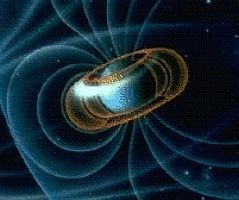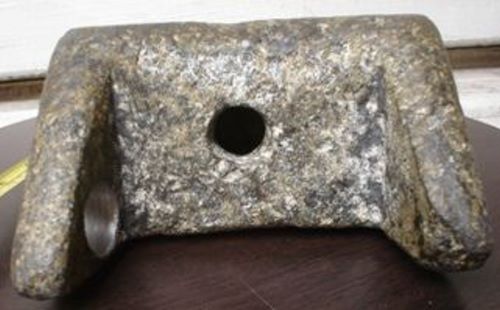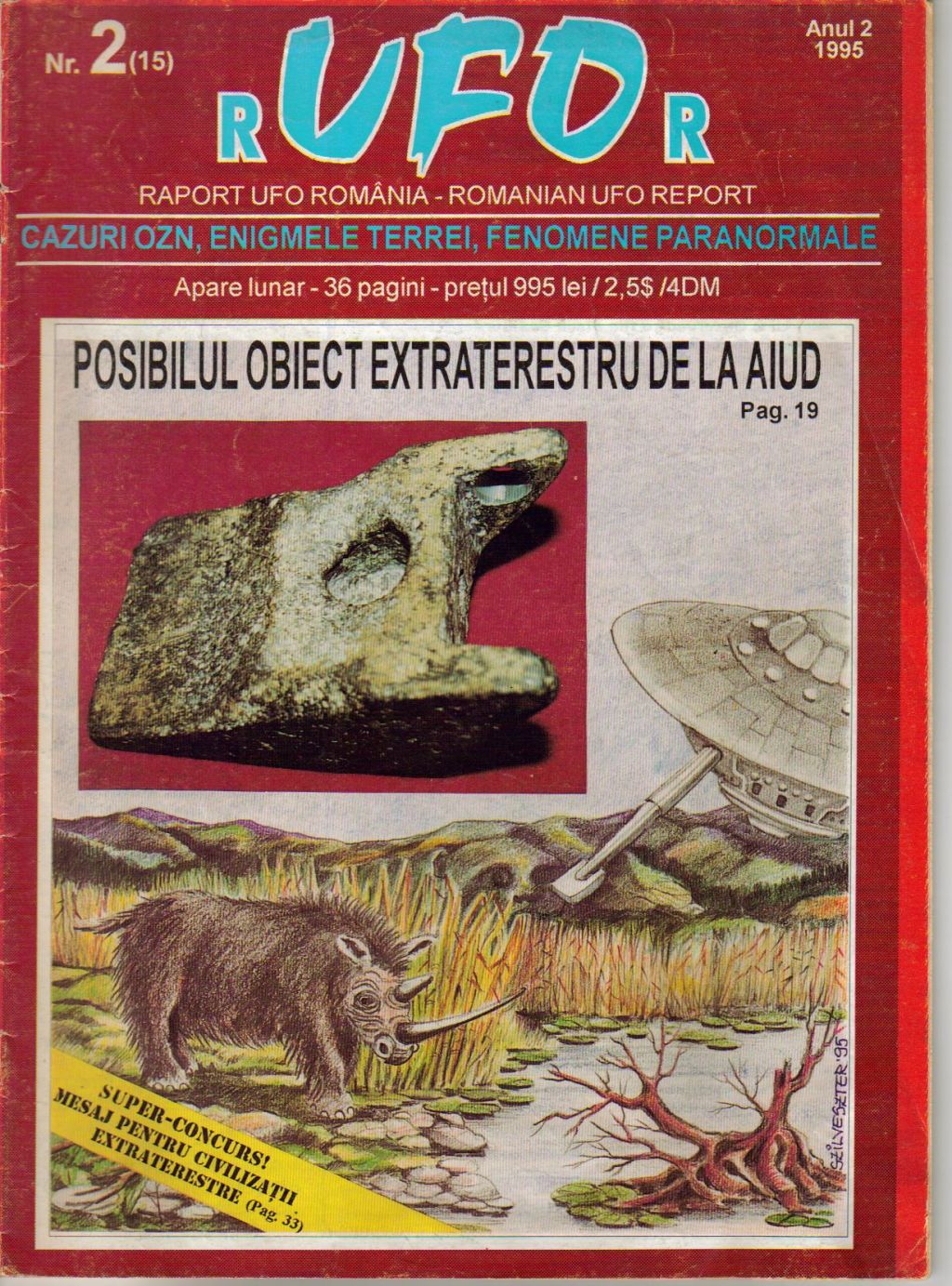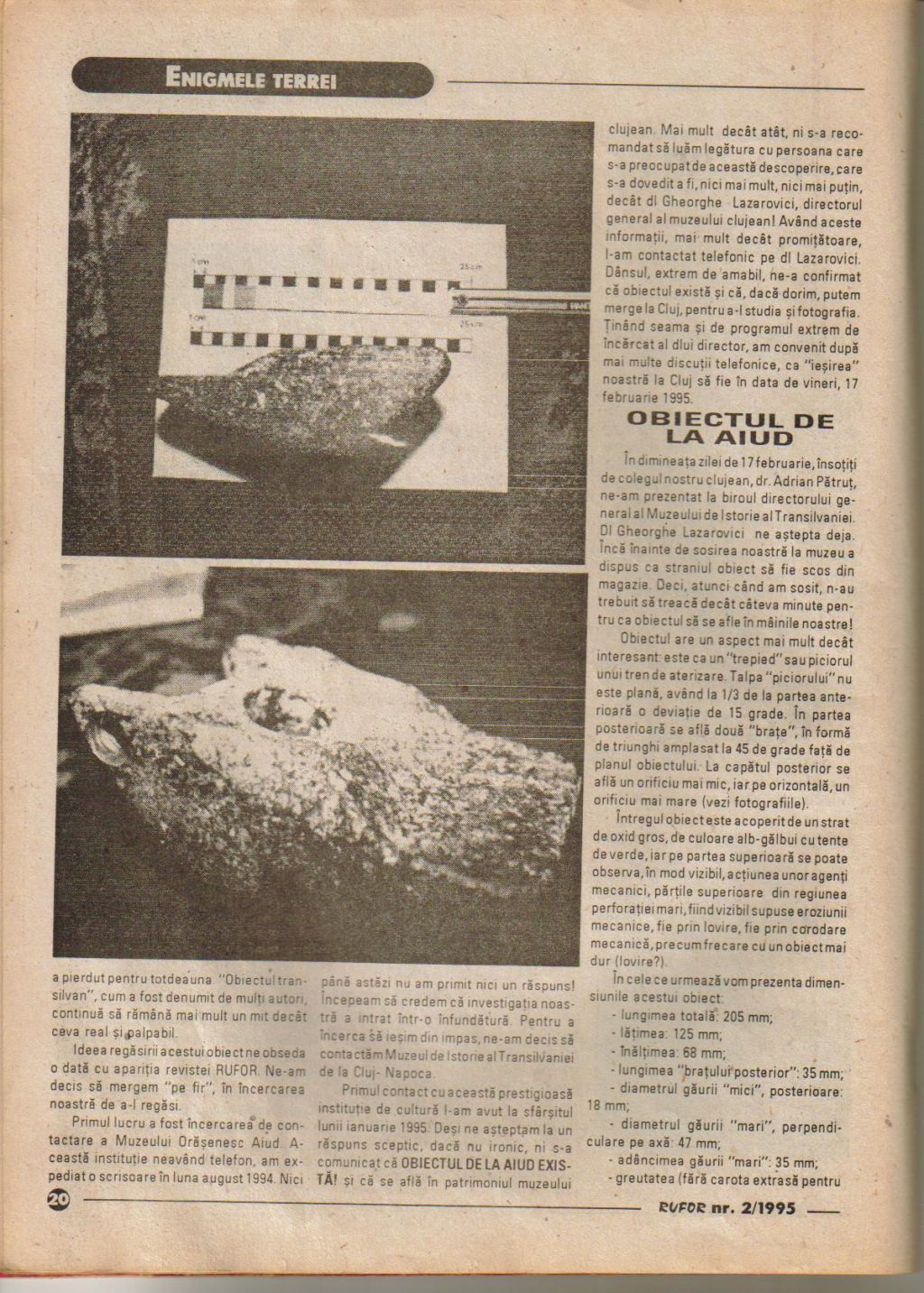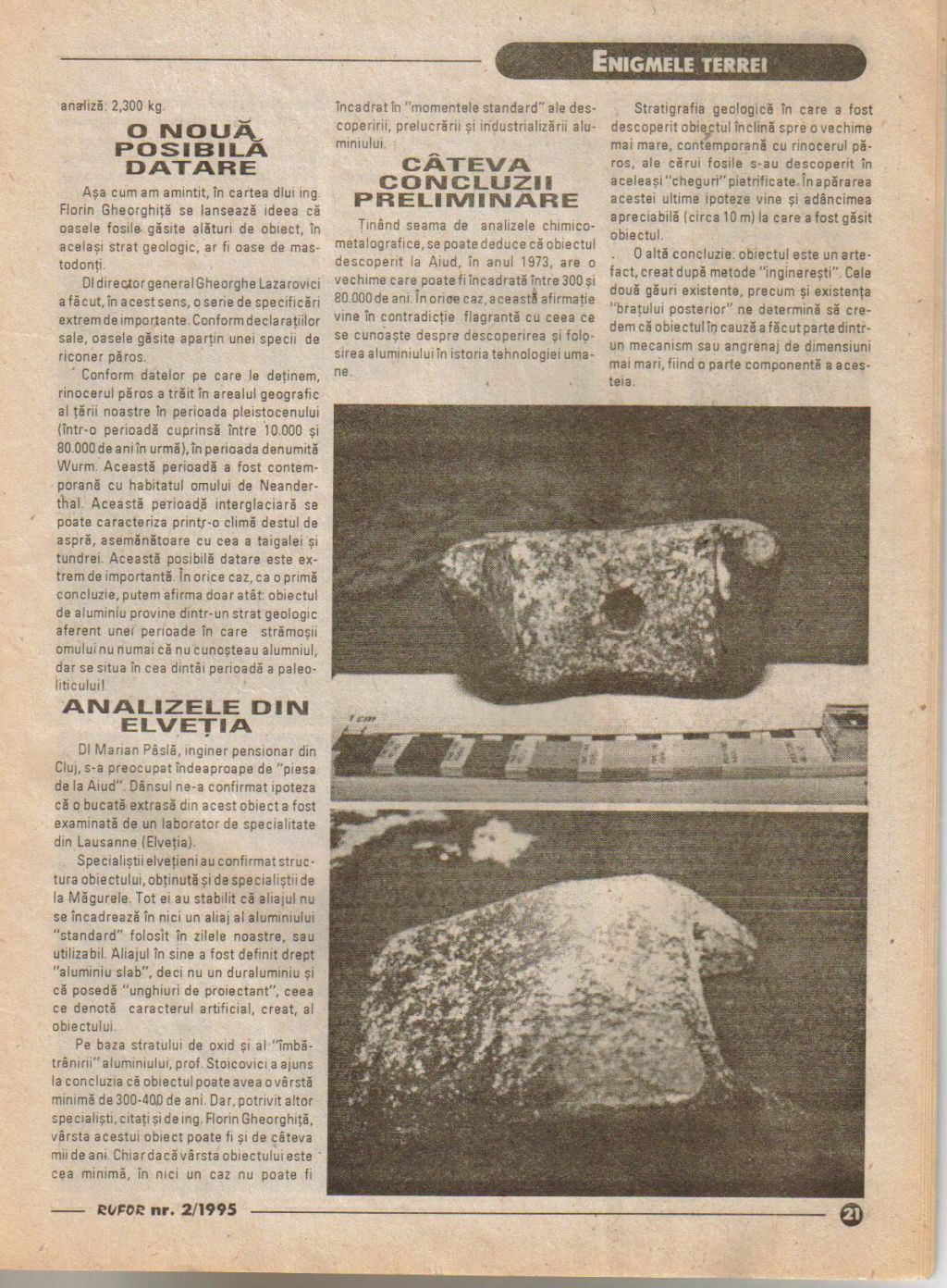|
|
|||||
|
..
Originally posted by Nairda ATS Post ID 10668317 OK - I see that you guys like the mysterious world unwrapping before our eyes. Now let me tell you about the mother of all mysteries subjects with a direct tie into the Bucegi mountains discovery. And this is not speculation or hypothesis it is REAL. The story begins in the the area which by today description
is the Transylvanian Plateau, near the city of Aiud.
A specialist was called on the site and he identified the objects as follows : two of the objects were fossils of animal origin and the third one appeared to be a stone axe which they assumed it helped the primitive man to kill the animal of which bones were found near. For a better and more in depth evaluation these objects were sent to the researchers from the city of Cluj Napoca. After carefully "unwrapping" the objects from the petrified sand cover the researchers from Cluj city discovered that the animal fossils belonged to a young mastodon ( mammals that look like today elephants but lived until about 800 000 to 1000 000 years ago) and the object was found to be not a stone axe - was not even stone it was METAL. So what you will say. Well the story just begins so hold on to your hats! Ok let's move on. A more detailed analysis of the object revealed more interesting and unbelievable facts. The objects had 2 cylindrical holes of different sizes done in such way that the hole with the smaller diameter perpendicular penetrated the base of the other cylindrical hole.The larger hole base was oval as it was done by a shaft with a rounded head part with which it appeared to have been assembled. The object has surface marks that indicates strong and repeated strikes some of them very powerful. All the details suggest that the object was part of a larger functional assemble and that the object was lost in the river bank because of an undetermined reason. Now the juicy part... REPEATED metal analysis will provide more questions than answers and the questions were huge. The analysis spreadsheet provided by ICPMMN (Magurele research institute) showed that the metal composition of the object was in fact a complex alloy made from 12 elements and the that 89% of the alloy was ALUMINUM. The other components were found to be; Silicone - 2.84%, Zinc - 1.81%, Lead - 0.41%, Tin - 0.33%, Zirconium - 0.2%, Cadmium - 0.0024%, Cobalt - 0.0023%, Bismuth - 0.0003%, Silver - 0.0002% and Gallium traces. SOOO the Object is basically made from ALUMINUM - and why is this so important you will ask? Because the age of the object was established to be 250000 years old !!! BECAUSE ALUMINUM WAS DISCOVERED IN 1825 BY OERSTED
IN HIS LAB AND THE INDUSTRIAL USE OF ALUMINUM BEGAN IN 1883
Did I got your attention now? I guess i did :-)
So what exactly is so mysterious about this object which in our days it can be found in the National History Museum of Transylvania from Cluj Napoca city in Romania ? Well let's go even further in analyzing this object. A very unusual feature of the object was that it was covered with an abnormal layer of aluminum oxide. It is known that this metal does not oxidize easy in depth and usually it covers itself with a thin layer of protective oxide which does not allow in depth oxidation.This can be explain only by the extreme age of this object. One of the researchers actually commented that it seem crazy but we are looking at an aluminum with an aged structure where the alloy parts are regaining their primordial structure. None of the researchers ( archaeologists, engineers and university professors) could explain the use of the object or find a similar shape object with the exception of one specialist in aviation. He suggested that this piece could very well be part of a landing base from a light to medium aerial vehicle which could do vertical takeoff and landing. So in other words did somebody flew in the Prehistoric times in that area and lost part of the landing gear on the river bank? That leaves us to the conclusion that Earth was visited a long long time ago by "intelligent and superior" beings which came from other worlds like we are preparing to do in the near future. So is very possible that they have in fact they created the secret chambers, tunnels and installed such recording devices in the Bucegi mountains. As one reader of this thread earlier suggested if the government want to keep something secret it will. Otherwise why the museum refused to send the object to be part of an Exhibition organised by Erik von Daniken, the renowned researcher and expert author of the book "Chariots of Gods" (ridiculed by the today so called "scientist") a book which by the way I read and deals with subjects in the same area like the Nazca lines etc. Now you see the connection... Original Source: Asfanufo.ro/opinii-i-ipoteze-g/paleoastronautica/ Related Links:
|
|||||
| Originally posted by lisa2012
ATS
Post ID 10671249
After some research there are few hypotheses for this object. One of them is expressed by an aeronautical engineer. An aeronautical engineer who examined the object, compared the object with a point of support for a smaller version of a module for space exploration, such as a lunar module, or for the foot of a Viking probe. According to this hypothesis, the object as part of a spacecraft, may have got worse, after a forced landing. So what is the real origin of the Aiud piece? Could it be that had extraterrestrial origin or there has been advanced civilizations before ours? You can see in this magazine from 1995 Romanian Magazine authentic photos of the object as published back in those days : In this photo you can see how this piece could have been the foot of a moon landing module or of a probe;
Originally posted by flk1331 ATS Post ID 10677474 My bad, I didn't notice that a page was missing. I knew something was wrong when i saw that the beginning wasn't there. Here we go again: First page: An amazing discovery For the first time we find out about the scandalous object discovered in the summer of 1973 in Aiud. From Florin Gheorghita's book (1983), "Enigmas in the galaxy", printed by "Junimea" Iasi. In the 6th chapter, "Visits on the blue planet", page 152, the author describes the history of the sensational discovery in Aiud. According to the author, in 1973, near Aiud, during excavations in a sand quarry, in a 10m deep layer, they found "3 objects encased in a shell of pressed sand"(quote page 152). An expert called to the scene "identified one of the objects to be a fossilized bone"(quote page 153). The expert reorted the findings to Cluj-Napoca. Here ends the first part of the bizarre discovery's odyssey. A surprise object Experts cleared the sediment layer from the most bulkiest object. It was no small surprise when they discovered that it was a weird shaped, metallic object with obvious signs of being manufactured. According to the Iesean author, the other 2 relics were part of the "skeleton of a mastodon"(quote pg 153). Intrigued by the item's aspect and the fact that in such an old geological layer they found an artificial metallic object, Clujean experts sent fragments for analysis, at the centre of research at ICPMMN Magurele. Another surprise: An ancient aluminum object! The performed analysis baffled even the experts from Magurele. The object was composed from an alloy of aluminum with ingredients from other rare metals. Let's look at the conclusions of these experts, reproduced in the book of the Iesean engineer: "(...) it was a complex alloy composed from 12 diverse elements, dosed in different percentages. The main ingredient - the big surprise - was aluminum (89%)! The rest of the component elements that were found (in the order of the size of the determined percentages): copper (6.2%), silicon (2.84%) zinc (1.81%), lead (0.41%), tin (0.33%), zirconium (0.2%), cadmium (0.11%), nickel (0.0024%), cobalt (0.0023%), bismuth (0.0003%), silver (0.0002%), galium (traces)." (quote pg 154). The same experts were surprised that the layer of aluminum oxide from the surface of the object and also being surprised of the state of "aging" of the object itself. Some things about aluminum *History of aluminum and some facts* 3rd paragraph:
Lost
paths, refound path
The sensational discovery in Aiud was repeated by many authors, but none of them tried to find it at least. The answer to a letter sent to ing. Fl. Gheorghita in 1987 was disarming: "sadly, the location of the object from Aiud is unknown.". I thought that the same thing would happen as in the case of other bizarre objects discovered everywhere around the globe, which...
Second page: ...were lost forever ."Transylvanian object", the name used by many authors, continues to remain just a myth instead of something real and tangible. The idea of finding this item again was obsessing us with the apparition of the magazine RUFOR. We decided to "walk on the wire", in our attempt to find it. The first thing we did was to contact the Museum in Aiud. We mailed this institution, because of it not having a phone, in August 1994. Not even to this date have we received an answer! We started to think that our investigation reached a dead end. In our attempt to get out from this impasse, we decided to contact the History Museum of Transylvania in Cluj-Napoca. Our first contact with this prestigious institution was made at the end of January 95. Even if we expected a skeptic answer, if not ironic, we were told that THE OBJECT FROM AIUD EXISTS! and that it is found in the heritage of the Museum in Cluj. More than that, we were recommended to keep in touch with the person that was preoccupied with this finding, which was proved to be none else than the director of the Museum in Cluj! Having this informations at hand, more than promising, we telephonically contacted mr Lazarovici. Very amiable, he has confirmed that the item exists, and, if we want, we can go to Cluj to study and photograph it. Considering his busy schedule, we agreed on more telephonic discussions and that our "trip" to Cluj to be on Friday, February 17 1995. The Object from Aiud In the morning of Feb 17, accompanied by our colleague from Cluj, Dr Adrian Patrut, we presented ourselves to the office of the director of the HM of Transylvania. Director Gheorgha Lazarovici was expecting us. Even before we arrived, he had prepared the strange object for us. So, when we arrived, we only had to wait a few minutes before the item was in our hands! The object has a more than interesting aspect: it is like a tripod or like a foot of a landing gear.The base of the "foot" wasn't plane, having 1/3 of the frontal side a deviation of 15 degrees. In the rear, there were two "arms" in the shape of a triangle placed at 45* from the plane of the object. At the rear end, there was a small orifice, and horizontally a bigger orifice (see pics). The entire object was covered in a layer of thick oxide, of a white-yellowish colour with a green tint, and on the upper part one could observe, visibly mechanically eroded, either by hitting, either by mechanical corrosion, such as friction with a tougher object (collision?). Following, we we'll present the size of this object:
Originally posted by flk1331 ATS Post ID 10677474 Third page: A new possible dating: As we recall, in Florin Gheorghita's book the idea was put forward that the bones found near the object in the same geological layer, were mastodon bones. Director Gheorgha Lazarovici made some very important statements about this subject. According to his declarations, the bones found were from a species of hairy rhino. According to our data, the hairy rhino (TL note: no real species name, sorry) lived in our geographic area during the Pleistocene era (10000-80000 years ago), in the Wurm era. This period was contemporary with the habitat of the Neanderthals. This interglacial period can be characterized with a pretty harsh climate, similar to the one of the taiga and tundra. (...). As a priliminary conclusion we can affirm only this: the aluminum object was from a geological layer from a period in which our human ancestors not only had no knowledge of aluminum, but it was from the first Paleolithic Era! Swiss analysis Mr. Marian Pasla, retired engineer, was closely connected with the "object from Aiud". He confirmed the hypothesis that a piece extracted from this object was examined by a laboratory in Lausanne (Switzerland). Swiss experts confirmed the composition of the object, the same as the one from Magurele. As well, they stated that the alloy did not fit in any of the "standard" alloys we use today, or usable. The alloy was defined as "weak", not a duralumin and that it has "designer angles", which denotes the artificial characteristic of the object. At the base of the layer of oxide and of the "aged" aluminum, Prof. Stoicovici reached the conclusion that the object could have an age of at least 300-400 years. But, according to other specialist, cited by Florin Gheorghita, the age of this object could even be of thousands of years. Even if the age of the object is the minimum one, in no way can this item be fitted in the "standard moments" of the discovery, processing and industrialization of aluminum. A few preliminary conclusions Taking into consideration the chemo-metallographic analysis, we can conclude that the item discovered in Aiud, in 1973, has an age that can be fit somewhere between 300 and 80000 years. In either case, this affirmation comes in contradiction with what it is known about the usage of aluminum in the technological history of humans. The geological stratigraphy [1] shows that the object inclines to an older age, contemporary with the hairy rhino, fossils of which were found in the same petrified layers. In the defence of this last hypothesis comes and the considerable depth at which the object was found (~10m). Another conclusion: the object is an artefact created after "engineering" methods. The two existent orifices, as well as the existence of the "rear arm" determines us to believe that this item was part of a landing gear of large dimensions, being a component of it.
Originally posted by flk1331 ATS Post ID 10677474 Forth page: What could it be? Of course, the temptation of expressing some other hypothesis is great. Yet, we can not not remark the fact that the shape and characteristic of this object are strikingly similar with the landing gear of a drone or spacial robot. As Florin Gheorghita assumes in his quoted work, the
object could have collided with a furious being (the hairy rhino), and
has partially deteriorated, losing a part of its landing gear, resulting
in the death of the "curious fellow" (TL note: forced translation. added
fellow for meaning) Or: if the hypothetical item was completely destroyed,
the rest of the parts could still be buried somewhere deep in the ground,
near Aiud.
A unique object on the global scale A lot has been written about metallic objects (iron or steel), found in coal mines, million year old geological layers. But to this date, nothing but descriptions remain, the objects have disappeared. It is also spoken of aluminum chest plates, discovered in the tombs of ancient Chinese emperors; but unlike the referenced literature, none of these were seen by a certified researcher. Doru Davidovici, in his book, "Galactic worlds", speaks of a goddess made of "oricalc", discovered in a coal mine, somewhere in Valea Jiului, but which disappeared in even more mysterious conditions. From the panoply of bizarre evidence in this field (another terrestrial civilization?, another technology?, random visitors from the Cosmos?). THE ONLY ONE THAT EXISTS, THE ONLY ONE THAT WAS ANALYZED AND STUDIED BY EXPERTS IN THE FIELD, THE ONLY ONE THAT WAS "RE-FOUND" AND PHOTOGRAPHED is right here, at our side, at the Museum of History of Transylvania in Cluj-Napoca. It is not improbable that this artifact discovered at Aiud is another vision of ours about the human being, technology and the Universe... With italics: Credits That's all folks! Source: Rufon.org/forum/ |
|||||
| Aliens have lost something in
Aiud
Ulpia Journal - December 10,
2004
Aiud could be a sort of Roswell Romania. Only that it is a few thousand years older. Unlike the small American town in New Mexico, that became famous in 1947 after a UFO crashed there, in Aiud no one not developed pilgrimages in search of traces of the aliens. The subject is known only by hardcore paleoastronauticã [ancient astronauts] researchers who do not speak very much about it... "There are footprints imprinted in rocks 500-600 million years old from Berea (Kentucky) or at Antelope Springs (Utah). Unexplained technical objects were found embedded in stone formed as a result of thousands or millions of years, Schöndorf (Austria); COSO Mountains (California); in a riverbed in Narada (Eastern Urals, Russia); even in Romania near Aiud by the river Mures. Could it be they are signs that someone is visiting for a long time?"Modern history of mankind has seen the discovery of bizarre objects, which normally should exist for the simple fact that people did not have the technique necessary for their manufacture. An example is the mysterious object in Aiud, discovered 30 years ago, an object that is considered by some specialists to be an alien artifact. Two miles east of Aiud unearthed in 1974 by a group of workers who worked in a sand pit on the Mures River, at a depth of ten meters, they found three objects. Two proved to be the fossilized bones of a mammoth, an animal that disappeared over a million years ago from Earth's surface. The third [object] gave much trouble to the specialists that examined it. A metallic object about 20 cm is hammer shaped there are two cylindrical holes of different diameters which are perpendicular. In the bottom of the larger hole one can observe an oval chamber, probably a socket of an axis with rounded head. The object was examined by Dr. I. Niederkorn, Institute for the Study of Metals and Minerals in Magurele. Aiud citizens millennia ago could not produce aluminum Tests have determined that the material that the object is composed of is an alloy consisting of 12 elements. Base material is 89 percent aluminum. Other factors identified are: copper-6.2%; silicon-2.84%; zinc-1.81%; lead-0.41%; tin-0.33%; zirconium-0.2%, cadmium-0.11% , nickel, cobalt, bismuth, silver and traces of gallium, the latter in very small quantities. Material of the piece of metal, aluminum, aroused curiosity. Aluminum was discovered for the first time in 1825 and only the late 19th century firat axtracted for industrial use, requiring almost 1,000 degrees Celsius temperatures. Aluminum can be found in nature only in the form of minerals. At the same time the object was covered by an oxide layer thicker than one millimeter. Aluminum oxidizes in the presence of oxygen, covering itself with a very thin oxide layer. Thickness of this layer over an inch, not only are not known but requires a prolonged action of oxygen, over a few thousand years, thus reinforcing the evidence that pointed object is very, very old. The object shows many dents and scratches that could come from some powerful blows. A base[foot] for aircraft landing? Aircraft Engineer Michael Hesemann proposes an interesting theory regarding the origin of the object, saying that it could come from a small-scale flying object and it could be a foot for landing. Computer expert Dan D. Farcas, PhD in Mathematics and Vice Aeropsatiale Romanian Association for the Study of Unidentified Phenomena, believes that the Aiud mysterious artifact is simply one of innumerable signs of visits by an alien civilization more evolved than humans... The mysterious artifact is currently reside in the Aiud Museum in Cluj Napoca. Nicu Popescu
|
|||||
| FAIR USE NOTICE: This page contains copyrighted material the use of which has not been specifically authorized by the copyright owner. Pegasus Research Consortium distributes this material without profit to those who have expressed a prior interest in receiving the included information for research and educational purposes. We believe this constitutes a fair use of any such copyrighted material as provided for in 17 U.S.C § 107. If you wish to use copyrighted material from this site for purposes of your own that go beyond fair use, you must obtain permission from the copyright owner. | |||||
|
|
